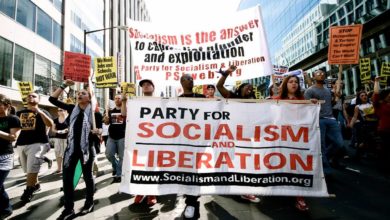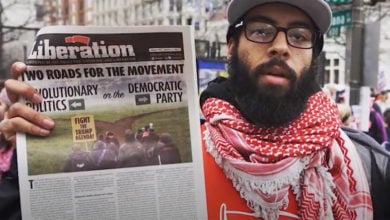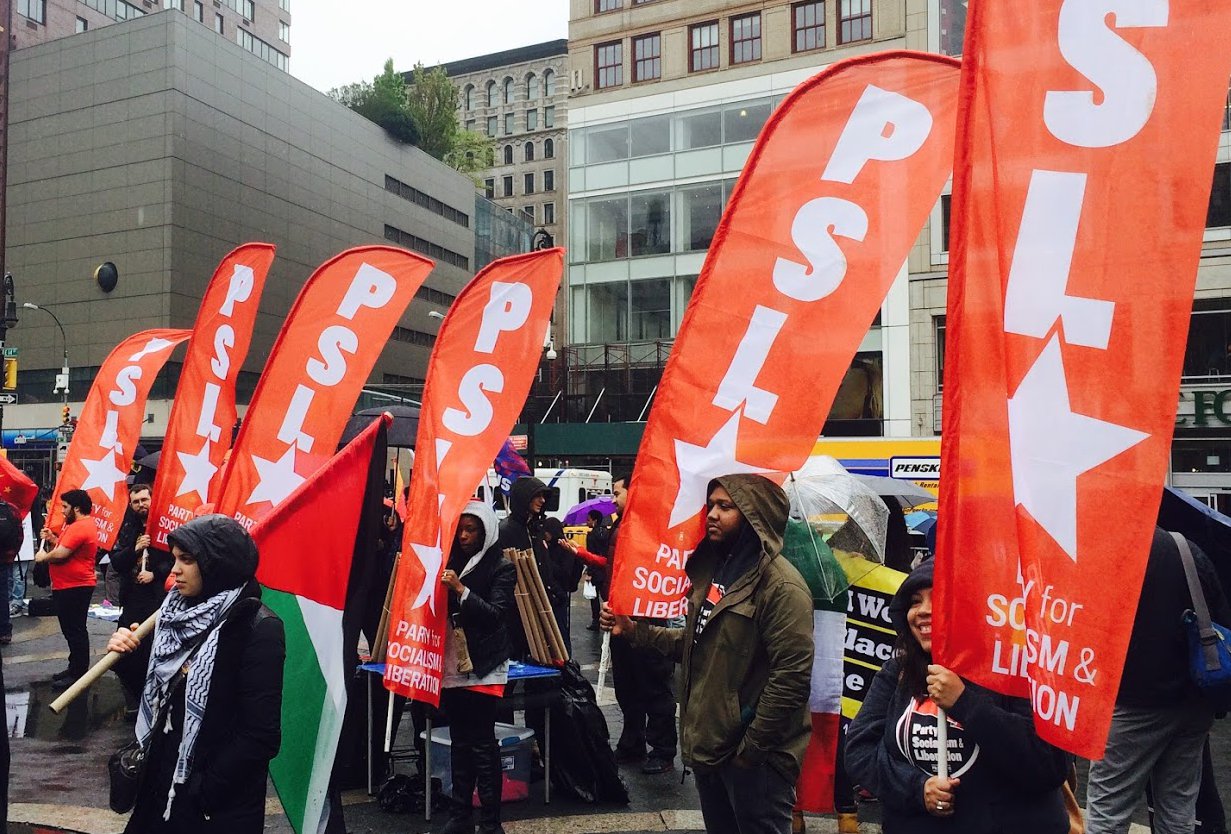Following is a talk
given in a panel titled “Fighting to win: How to defeat immigrant bashing,
anti-LGBT bigotry, Islamophobia and the ultra right” at the Nov. 13-14, 2010,
National Conference on Socialism sponsored by the Party for Socialism and
Liberation.
I have been asked to speak about the political right-wing in
this country—how we can both understand the right and formulate a strategy to
defeat it. I do not think I need to impress upon any of you the seriousness of
this subject. The Republicans have just won quite an enormous shift in the
Congressional elections, as well as state legislatures and governorships. Many
campaigned on the basis of attacking immigrants and cutting social spending,
and stopping what they call the “progressive agenda,” under which falls
everything from LGBT rights to environmental regulations. If history is any
guide, this is not idle talk; when politicians promise to strengthen the rule
of the capitalist class, that is at least one promise we can assume they will
try to carry out.
I want to begin just by defining what we mean by right wing.
The core of right-wing politics has always been business conservativism: to
oppose government regulation and interference into the “natural” functioning of
the capitalist system and the inequality it produces. In this country, the
right has focused their attack on “big government,” especially in relation to
social programs, and particularly with most oppressed sectors of society:
immigrants and African Americans.
So if we define this as the core of right-wing politics, we
would have to acknowledge that that program has been triumphant, winning
victory after victory for the last 35 years. It is not really a question of
policy; it is a question of a long-term trend in capitalism for a third of a
century. Both Republican and Democratic parties accepted and projected the
economic logic of Wall Street as “common sense.” That is the first argument I
want to put out there for us to think about: that both parties are right wing.
I don’t mean this as a slur or an exaggeration. I mean it seriously. You cannot
explain the long-term, right-wing trend in politics and the economy by just
talking about the conniving Republicans.
The Democrats have had no other strategy when it comes to
de-industrialization, the attack on labor unions and the cuts to social
spending. They had no other response to the housing crisis, to the collapsing
financial sector. On all these fronts, the Democratic leadership has followed
the same formula: bail out the banks, not the people, and spread the lie that
“business confidence”—that is, the happiness of Wall Street—will eventually
trickle down to the rest of us.
The Democrats’ loyalty to the capitalist system is
particularly obvious in these times of economic crisis. In times of growth, the
Democrats showed themselves willing to very mildly redistribute wealth and
grant concessions as a means of preserving social peace. But not now.
What about the Tea Party?
None of this is exactly a revelation—yes, many people will
say, but we already knew that the Democrats were a capitalist party. But aren’t
there differences between reactionary and progressive capitalists that we need
to understand and exploit to understand our own line of march? The Tea Party
looks like a white supremacist mob—some go as far to call them fascist in
character. With that mob approaching, are we really going to say they are the
same as the Democrats? At the very least, you could argue, the Democrats are
against the Tea Party.
To answer that, we first need to get a solid understanding
of where the Tea Party comes from, and what its appeal is right now. Most
people peg the beginning of the Tea Party movement with a Feb. 19 rant on the
Stock Market floor from CNBC’s Rick Santelli. Santelli was irate at the idea
floated by the White House of mortgage modification for distressed
homeowners. In the middle of the video, he says “We’re thinking about
having a Chicago Tea Party in July. … All you capitalists that want to show
up to Lake Michigan, I’m going to start organizing.” He points to the
traders and says “This represents a pretty good cross-section of America.
The silent majority!” All the stock traders start hooting and hollering in
support.
The video went viral, and within a week conservative
activists had begun organizing “Tea Party” protests across the
country. That is a useful fact to remember when we are talking about the Tea
Party. According to a recent poll, a majority of people in the country are
worried about themselves being foreclosed and evicted; meanwhile, the Tea
Party, which claims to speak for the “silent majority,” began on Wall
Street as a traders’ revolt against mortgage modification.
The Tea Party was not just that, however. It ironically drew
from a lot of the outrage of the bank bailout, and really caught on as a
movement against President Obama’s health insurance reform, which they falsely
called socialistic. The Tea Party activists call just about everything
socialist now—environmental regulation, the Federal Reserve, the income tax,
Medicare and Social Security. Their movement, which is given national voice
every night on Fox News through Glenn Beck among others, revives an old
McCarthyite, conspiratorial strain in conservative politics.
Although almost completely white, the Tea Party does not
represent white America in total. Tea Party activists and hardcore loyalists in
particular tend to be more affluent, upper middle-class people—small businessmen,
insurance agents, salesmen, etc. They are not industrial workers; they are not
working-class college students. They are not new to politics. In some way, you
can say the Tea Party just gave a name to the 20 percent of very conservative
older, often racist white people who have always been around.
But calling the Tea Party a bunch of grumpy old racists, or
hacks for Wall Street, doesn’t really say enough. Around 40 percent of all
voters on Nov. 2 said they had some affinity or respect for the Tea Party—a
number which has grown dramatically in the last year. This is not because the
country has shifted to the right, or have become rabid racists.
A large bulk of the Republican gains in the House of
Representatives happened in the Midwest region, which has been hit particularly
hard by decades of de-industrialization and the last two years of economic
crisis. The Republican and Tea Party message about cutting “big
government” struck a chord in this region for a reason. Conservative
politicians say it is because the population is more ideologically right-wing
than liberals understand. Meanwhile, many liberals and progressives attribute
the Republican appeal to stupidity and backwardness.
Both are wrong. There is a deep frustration about government
spending (such as the $800 billion stimulus) because “big government”
appears to do nothing to alleviate the region’s problems. These voters assumed,
not unreasonably, that all the tax-payer dollars being spent are going into
other people’s pockets. They see “big government” as the bailout of GM, in
which the government took over the industry briefly just to lay off more
workers.
Our fight at this moment is necessarily defensive: against
budget cuts, against new repressive laws against immigrants, and so on. But our
defense does not include defending the Democrats as somehow a better
alternative. As in any sport, our best defense will be a good offense –
constructing a movement of poor and working people. We have to show that the
socialists are in fact the true opponents of the current government, of the
whole system. We are the true populists. Instead of the libertarian critique of
“big government,” we have to raise the idea of a people’s government
– a government that provides and meets people’s needs, and returns to workers
the product of their labor.
I’ll end with one example of how
our party can make steps in this direction. On Oct. 2, around 200,000 workers
came to Washington D.C., in the “One Nation” march.
Unlike the Tea Party rallies,
the “One Nation” demonstration was broadly representative of the U.S. working
class. In addition to the huge outpouring from the predominantly Black churches
and unions, delegations from a broad range of nationalities attended, bringing
their own demands and concerns. At a time when right-wing demagogues like Beck
and more extreme racists claim to speak for white people in the United States,
it was significant that half of the participants of the multinational “One
Nation” rally were white.
Anyone who held stereotyped views of union workers as narrow minded or
only concerned about “America first” would have been surprised by the extent to
which the vast crowd was open to a progressive agenda. Anti-war activists
received a warm welcome in the crowd, and signs and banners calling for an end
to the wars in Iraq and Afghanistan were widespread. LGBT activists were
embraced as well. Socialists got a good reception.
That is not to say that the day was without shortcomings. The
orientation of the rally organizers, reflected uniformly in the message of
speaker after speaker, was toward the Nov. 2 midterm elections. So instead of
hearing a message to embrace their own power, the masses of workers who turned
out on Oct. 2 were directed to hand over their power to a handful of big business
politicians. They were told over and over that they were part of “one nation,”
but were not told that there were two major classes, and that the enemy class
has two political parties.
We went to this demonstration in
full force, and organized our friends and contacts to come with us. We passed
out anti-war, anti-racist signs and distributed clear anti-capitalist
literature to the workers present. It would have been a mistake to abstain from
such a rally because the Democrats were behind it. For the workers who came,
they came to be a counterpoint to the fake populism and racism of Glenn Beck.
So we had to be there with them. But it would be an equal mistake to believe
that the Democrats are looking to intensify the struggle against the Tea Party,
to stop the right-ward trajectory in politics, or would ever encourage the
workers to exercise their power in society. There are two sides of our
strategy, a socialist strategy. We have to be with everyone who wants to fight
the right, but be clear that the rightward trend cannot be defeated by siding
with “good” capitalists over “bad” capitalists. All wings of the capitalist
class are headed in the same direction, and it will take a mass movement to
overthrow capitalism to turn it around. That is a big task—and we are not the
first to articulate it—but that is the task nonetheless.





